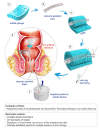Introduction of a handmade vacuum-assisted sponge drain for the treatment of anastomotic leakage after low anterior rectal resection
- PMID: 34111349
- PMCID: PMC9263312
- DOI: 10.3393/ac.2021.00059.0008
Introduction of a handmade vacuum-assisted sponge drain for the treatment of anastomotic leakage after low anterior rectal resection
Abstract
Purpose: Anastomotic leakage, a known major postoperative complication, potentially leads to readmission, reoperation, and increased mortality rates in patients, such as rectal cancer patients following a low anterior resection (LAR). Currently, vacuum-assisted closure, as featured by B-Braun (B-Braun Medical B.V.), is already being used for the treatment of gastrointestinal leakages and fistulas. The main aim of this study was to introduce a novel method for creating a vacuum-assisted drain for the treatment of anastomotic leakage after LAR.
Methods: All 10 patients, who underwent LAR surgery from 2018 to 2019, were diagnosed with anastomotic leakage and had received neoadjuvant chemotherapy prior to surgery. Therefore, patients were treated with a handmade vacuum-assisted drain and were revisited every 5 to 7 days for further evaluations and drain replacement until leakage resolution. Physical features of cavity, time of diagnose, and duration of treatment were analyzed correspondingly. The handmade vacuum-assisted sponge drain was prepared for each patient in each session of follow-up.
Results: Eight out of 10 patients experienced complete closure of the defect. The mean delay time from the day of operation to the diagnosis of anastomotic leakage was 61.0±80.4 days while the mean time for leakage closure was 117.6±68.3 days. Eventually, 7 cases underwent ileostomy reversal with no complications during a 3-month follow-up.
Conclusion: In this study, we evaluated the healing process of anastomotic leakage after the usage of a handmade vacuum-assisted sponge drain in a case series method. In our trial, we provided an innovative cost-benefit method easily applicable in the operating room.
Keywords: Anastomotic leak; Drainage; Negative-pressure wound therapy; Rectal neoplasms; Vacuum.
Conflict of interest statement
No potential conflict of interest relevant to this article was reported.
Figures



References
-
- Buchs NC, Gervaz P, Secic M, Bucher P, Mugnier-Konrad B, Morel P. Incidence, consequences, and risk factors for anastomotic dehiscence after colorectal surgery: a prospective monocentric study. Int J Colorectal Dis. 2008;23:265–70. - PubMed
-
- Pepe G, Magalini S, Callari C, Persiani R, Lodoli C, Gui D. Vacuum assisted closure (VAC) therapyTM as a swiss knife multi-tool for enteric fistula closure: tips and tricks: a pilot study. Eur Rev Med Pharmacol Sci. 2014;18:2527–32. - PubMed
-
- Loske G, Schorsch T, Müller C. Endoscopic intracavitary vacuum sponge therapy of anastomotic leakage in the proximal colon after right-sided colectomy. Endoscopy. 2010;42 Suppl 2:E171–2. - PubMed
-
- Li C, Zhao Y, Han Z, Zhou Y. Anastomotic leaks following gastrointestinal surgery: updates on diagnosis and interventions. Int J Clin Exp Med. 2016;9:7031–40.
LinkOut - more resources
Full Text Sources
Miscellaneous

